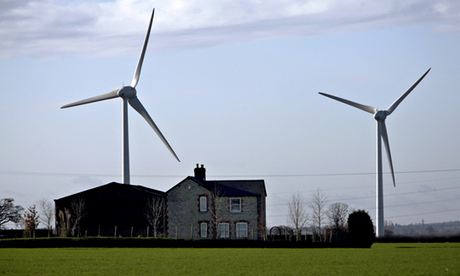Windfarms can reduce house prices by up to 12%, says LSE
04-09-2014
Findings contrast with earlier study – and will fan homeowners' demands for compensation when windfarms are approved

Windfarm operators pay rent on the land they occupy but have no obligation to compensate homeowners for loss of value. Photograph: David Sillitoe for the Guardian
Patrick Collinson
Large windfarms can knock as much as 12% off the values of homes within a 2km radius, and reduce property prices as far as 14km away, according to research by the London School of Economics. The findings contrast sharply with a report by the Centre for Economics and Business Research in March, which found no negative impact on property prices within a 5km radius of a turbine.
The LSE findings will fan demands by homeowners for compensation when windfarm developments are given the go-ahead. Currently, windfarm operators pay rent on the land they occupy and make contributions to community causes, but are under no legal obligation to compensate homeowners for loss of value.
The report, "Gone with the wind: valuing the visual impacts of wind turbines through house prices", by Professor Stephen Gibbons, found that "windfarm developments reduce prices in locations where the turbines are visible, relative to where they are not visible, and that the effects are causal".
For the average sized windfarm, the price reduction is around 5-6% for homes with a visible windfarm within 2km, falling to less than 2% between 2-4km, and to near zero between 8-14km, which is at the limit of likely visibility. In areas close to windfarms, but where the turbines are not visible, the report found there was a small increase (around 2%) in property prices.
Large windfarms cause the greatest decline in property prices. "As might be expected, large visible windfarms have much bigger impacts that extend over a wider area," said Gibbons. "The largest windfarms (20+ turbines) reduce prices by 12% within 2km, and reduce prices by small amounts right out to 14km (by around 1.5%)."
Gibbons said his findings are comparable to the impact of coal power plants, citing studies in the US which show that they cut house prices by up to 7% within a two mile (3.2km) radius.
He also looked at what housebuyers were prepared to pay to avoid the "dis-amenity associated with windfarm visibility".
"The implied costs are quite substantial. For example, a household would be willing to pay around £600 per year to avoid having a windfarm of small to average size visible within 2km, around £1,000 to avoid a large windfarm visible at that distance and around £125 per year to avoid having a large windfarm visible in the 8-14km range. The implied amounts required per windfarm to compensate households for their loss of visual amenities is therefore fairly large: about £14m on average to compensate households within 4km."
Gibbons's findings are in contrast to a report from the CEBR, commissioned by windfarm trade body RenewableUK, which analysed seven sites across England and Wales and found no negative impact on property prices within a 5km radius.
Maf Smith, deputy chief executive at RenewableUK, said: "This is an interesting contribution to the existing literature, and varying conclusions are being drawn from the work. Most pieces of work so far have found that it's difficult to discern any effect one way or another.
"Our own independent study demonstrates that windfarms have not affected house prices, and we did this by taking a deep dive into real house price data around seven windfarms across England and Wales.
"The LSE study tests for the influence of windfarms in a different way. It covers a shorter period rather than looking at the whole lifecycle of the project. It measures only from a central point at each windfarm site rather than taking into account every single turbine at the very edges of the development. It makes necessarily simple assumptions about visibility, when we know that in reality many sites will be hidden by nearby buildings, trees and the local landscape. We're grateful that the professor states that his work is not conclusive. It helps to explain why his findings don't accord with previous research that the CEBR, RICS and others have done."
But campaigners who have windfarms close to their properties welcomed the LSE research. George Matthews, a surveyor who lives on the Scottish borders, close to the Drone Hill windfarm, said: "We now have conclusive proof at last produced by a professional, trustworthy, honest and independent professional source stating categorically that turbines reduce house values, which totally contradicts the CEBR report."
Meanwhile, the Conservatives have given their strongest signal yet that they will halt windfarm expansion if they retain power after the next election. The Tory chairman, Grant Shapps, appeared to confirm Guardian reports that the Tories will pledge at the next election to cap the output of onshore windfarms from 2020.
Asked by the Western Morning News whether plans to curb windfarms would feature in his party's manifesto, Shapps said: "The wind is moving in a clear direction here."
But writing in The Guardian last week, former energy minister Chris Huhne said: "Everybody wants the convenience of electricity without the inconvenience of industrial kit anywhere near them. There is no energy source without venomous nimbies, but they are a minority. Onshore wind enjoys more than 60% support in polls, and offshore wind is even more popular."

